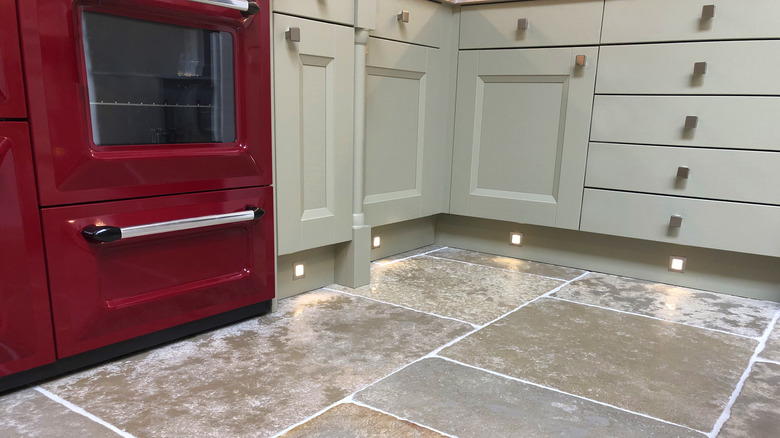Toe Kick Vs. Plinths: Which Is The Better Choice For Your Floor Cabinets?
The smallest differences sometimes spark the most confusing discussions, and so it is with the distinction between one base cabinet's toe kick and another's plinth. For clarity, let's use the term "flush plinth" for a flush-mounted skirting board at the bottom, that's flush with the front of the cabinet carcass rather than inset. We'll use "toe kick" for a recessed skirting board that's set in a few inches to accommodate a user's feet. Which you have doesn't usually make a lot of difference, except that recessed toe kicks are more ergonomic and accommodate lighting more easily, while flush plinths create a more built-in look.
But before going further, let's dispense with some confusing definitions. A plinth is a base upon which something is built — in this case, a cabinet — but it has entered popular usage as a reference to the skirting that covers the gap between the cabinet and the floor. To make matters worse, "plinth" is also used to refer to legs on which cabinets stand when they don't have a plinth. Yes: Plinth legs are for cabinets without plinths. And since "plinth" also refers to the covering, you could say that a plinth hides a plinth or, if there's no plinth, it hides plinth legs. Note, too, that some people also describe the flush skirting board as a type of toe kick, which makes sense; in fact, it's more likely to be kicked than a recessed one.
Design implications of flush plinths versus toe kicks
You occasionally hear the word "floating" applied to base cabinets with toe kicks, but what's actually going on is a bit different. The recessed toe kick gives the immediate impression of furniture rather than built-in cabinetry — that is, of discrete pieces set down upon the floor and movable on a whim. This look has gained a lot of popularity in American kitchens, and it's easily the norm for factory-made cabinets. To accentuate the furniture-ish look, many base cabinets come with protruding elements that interrupt the toe kick and give the impression of furniture legs.
Furniture with a flush plinth on the same plane as the cabinets (or even proud of it, meaning they protrude a little) gives a sense of solidity and integral, built-in construction. Design elements from the kitchen are sometimes carried over to the cabinet faces or the flush plinths, reinforcing this built-in look. The flush skirting approach might be making a comeback, given that HGTV's Emily Henderson recently decided not to add a toe kick to her kitchen cabinets. Flush plinths are also a way you can subtly bring the English country style into your home.
Practical considerations and how to utilize the space behind your skirting
If one gets the impression that this is much ado about nothing, that's not quite right. Aesthetics aside, there are quite consequential implications of the placement of that skirting board, or whatever you choose to call it. Recessed skirting is obviously a better host for cozy kitchen toe kick lighting. And recessed toe kicks are an ergonomic feature that make it possible for you to stand closer to the countertops without bending awkwardly forward, improving balance (and therefore safety), and keeping you from constantly reaching out, and thereby becoming sore and irritable after a long stretch of meal prep.
Of course, the cabinet's foundation (traditional plinth or hidden legs) is obscured with both skirting methods. And what you're hiding matters because it can affect what you do with that dead space under your cabinets. It's long been a growing trend to turn that wasted under-cabinet space into hidden bathroom or kitchen storage by installing toe kick drawers, HVAC vents, floor sweep or central vacuum inlets, or other useful bits so that the flush plinth or toe kick becomes the front of the drawer, vent cover, etc. Whether you have flush or recessed skirting, if there are legs behind it, they are likely to interfere with some installations — particularly drawers. All that's required to remedy this is a pair of boards that sit inside the legs and give your drawer slides something to hold on to.


